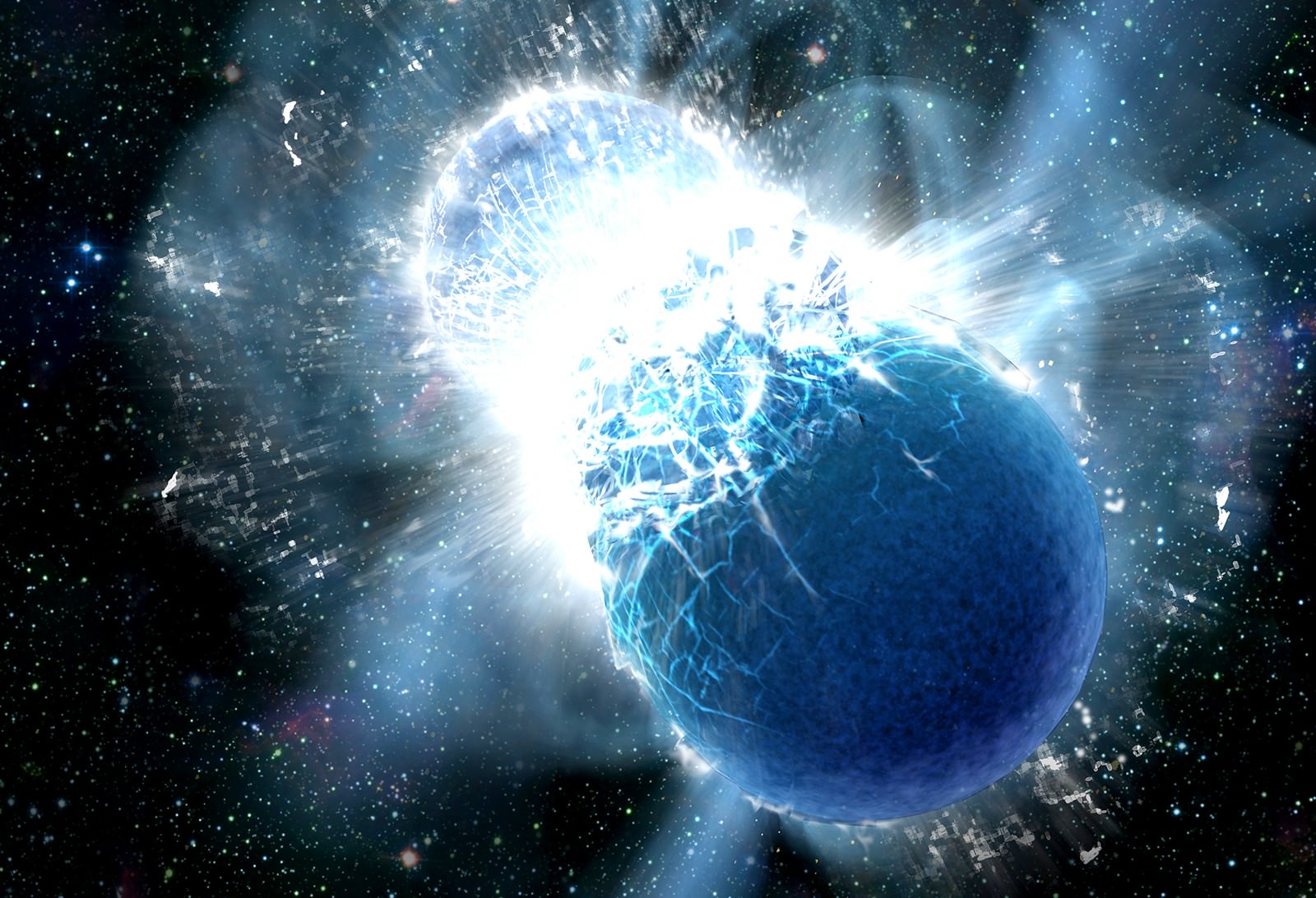Are you wearing a gold ring? Or perhaps gold-plated earrings? Maybe you have some gold fillings in your teeth… for that matter, the human body itself naturally contains gold — 0.000014%, to be exact! But regardless of where and how much of the precious yellow metal you may have with you at this very moment, it all ultimately came from the same place.
And no, I don’t mean Fort Knox, the jewelry store, or even under the ground — all the gold on Earth likely originated from violent collisions between neutron stars, billions of years in the past.
Recent research by scientists at the Harvard-Smithsonian Center for Astrophysics (CfA) in Cambridge, Massachusetts has revealed that considerable amounts of gold — along with other heavy elements — are produced during impacts between neutron stars, the super-dense remains of stars originally 1.4 to 9 times the mass of our Sun.
The team’s investigation of a short-duration gamma-ray outburst that occurred in June (GRB 130603B) showed a surprising residual near-infrared glow, possibly from a cloud of material created during the stellar merger. This cloud is thought to contain a considerable amount of freshly-minted heavy elements, including gold.
“We estimate that the amount of gold produced and ejected during the merger of the two neutron stars may be as large as 10 moon masses – quite a lot of bling!” said lead author Edo Berger.

The mass of the Moon is 7.347 x 1022 kg… about 1.2% the mass of Earth. The collision between these neutron stars then, 3.9 billion light-years away, produced 10 times that much gold based on the team’s estimates.
Quite a lot of bling, indeed.
Gamma-ray bursts come in two varieties – long and short – depending on the duration of the gamma-ray flash. GRB 130603B, detected by NASA’s Swift satellite on June 3rd, lasted for less than two-tenths of a second.
Although the gamma rays disappeared quickly, GRB 130603B also displayed a slowly fading glow dominated by infrared light. Its brightness and behavior didn’t match the typical “afterglow” created when a high-speed jet of particles slams into the surrounding environment.
Instead, the glow behaved like it came from exotic radioactive elements. The neutron-rich material ejected by colliding neutron stars can generate such elements, which then undergo radioactive decay, emitting a glow that’s dominated by infrared light – exactly what the team observed.
“We’ve been looking for a ‘smoking gun’ to link a short gamma-ray burst with a neutron star collision,” said Wen-fai Fong, a graduate student at CfA and a co-author of the paper. “The radioactive glow from GRB 130603B may be that smoking gun.”
The team calculates that about one-hundredth of a solar mass of material was ejected by the gamma-ray burst, some of which was gold. By combining the estimated gold produced by a single short GRB with the number of such explosions that have likely occurred over the entire age of the Universe, all the gold in the cosmos – and thus on Earth – may very well have come from such gamma-ray bursts.
Watch an animation of two colliding neutron stars along with the resulting GRB below (Credit: Dana Berry, SkyWorks Digital, Inc.):
How much gold is there on Earth, by the way? Since most of it lies deep inside Earth’s core and is thus unreachable, the total amount ever retrieved by humans over the course of history is surprisingly small: about 172,000 tonnes, or enough to make a cube 20.7 meters (68 feet) per side (based on the Thomson Reuters GFMS annual survey.) Some other estimates put this amount at slightly more or less, but the bottom line is that there really isn’t all that much gold available in Earth’s crust… which is partly what makes it (and other “precious” metals) so valuable.
And perhaps the knowledge that every single ounce of that gold was created by dead stars smashing together billions of years ago in some distant part of the Universe would add to that value.
“To paraphrase Carl Sagan, we are all star stuff, and our jewelry is colliding-star stuff,” Berger said.
The team’s findings were presented today in a press conference at the CfA in Cambridge. (See the paper here.)
Source: Harvard-Smithsonian CfA


Not to say this isn’t true, just asking – how then did all of it get into neat little seams in our crust? Gold core asteroids? Does gold attract itself into clumps?
I’m no geophysicist or mineral expert, but I have watched enough episodes of “Ice Cold Gold” to say that it tends to follow lines of certain minerals like iron… “gold rides an iron horse” they liked to say (repeatedly.) As far as where that came from, well… I assume what’s in the crust is just a smattering compared to what sunk into the core due to differentiation during the formation of the proto-Earth.
The little that humans have been able to gather is what’s been brought to the surface due to various geological activities in certain locations around the planet.
I remembered Bill Bryson’s “A short history of nearly everything” (excellent book) mentioned this. I don’t know his references.
Text copyed-pasted from an online .pdf I found:
“We now know that there are a lot of microbes living deep within the Earth, many of which have nothing at all to do with the organic world. They eat rocks or, rather, the stuff that’s in rocks—iron, sulfur, manganese, and so on. And they breathe odd things too—iron, chromium, cobalt, even uranium. Such processes may be instrumental in concentrating gold, copper, and other precious metals.”
Mineral veins in rocks form as a result of percipitation by an aqueous solution (water) carrying minerals dissolved in it.
I suspect (but don’t really know) that the geology consensus is that Earth will have much more mineral concentrations than other bodies. Because of plate tectonics but above all the chemical transformation and concentrations that the biosphere has made. (See Hazen et al.)
See e.g. the iron cycle Jason mentions, the iron in the crust is in an entirely new oxidation state because of life.
What I’d like to know.. is how much gold is in Ft. Knox? Is there any left? OR did we send it all to China to pay our debts? OR did we trade it for some of ET’s technology? LOL! Shhh… it’s a secret!
I wonder if events like this can produce superheavy trans-Uranium nuclei. There is supposed to be an “island of stability”, where some of these nuclei have long-ish halflives.
The element Helium was first discovered spectroscopically in the Sun. Could the same be possible for superheavy elements in neutron star debris?
Does any gold get created in core collapse supernovae, and where does it end up?
Some gold yes. The elements end up in molecular clouds, and then often in stars and their planetary systems.
@William: good question! The article is tantalizing but really incomplete. We’ve always heard that all heavy elements past iron came from core collapse, so do neutron stars add to that or replace that? Some heavy elements or all heavy elements? How does this change our view of stellar evolution and the composition of stellar remnants. There are probably no answers yet, but I would like to see some recognition that there are important questions generated by this discovery.
This is not a “finding” and nothing has been “revealed”. It is a pile-up of hypotheses, which is OK as long as that is made clear.
I can’t agree. There has been “a pile up” of hypotheses earlier, but this work was a test that constrained such theories:
“Although the gamma rays disappeared quickly, GRB 130603B also displayed a slowly fading glow dominated by infrared light. Its brightness and behavior didn’t match the typical “afterglow” created when a high-speed jet of particles slams into the surrounding environment.
Instead, the glow behaved like it came from exotic radioactive elements. The neutron-rich material ejected by colliding neutron stars can generate such elements, which then undergo radioactive decay, emitting a glow that’s dominated by infrared light – exactly what the team observed.”
It is a finding, of a way to test and constrain earlier hypotheses.
Other civilizations in other galaxies probably value gold as much as we do, unless it’s way more abundant on other planets.